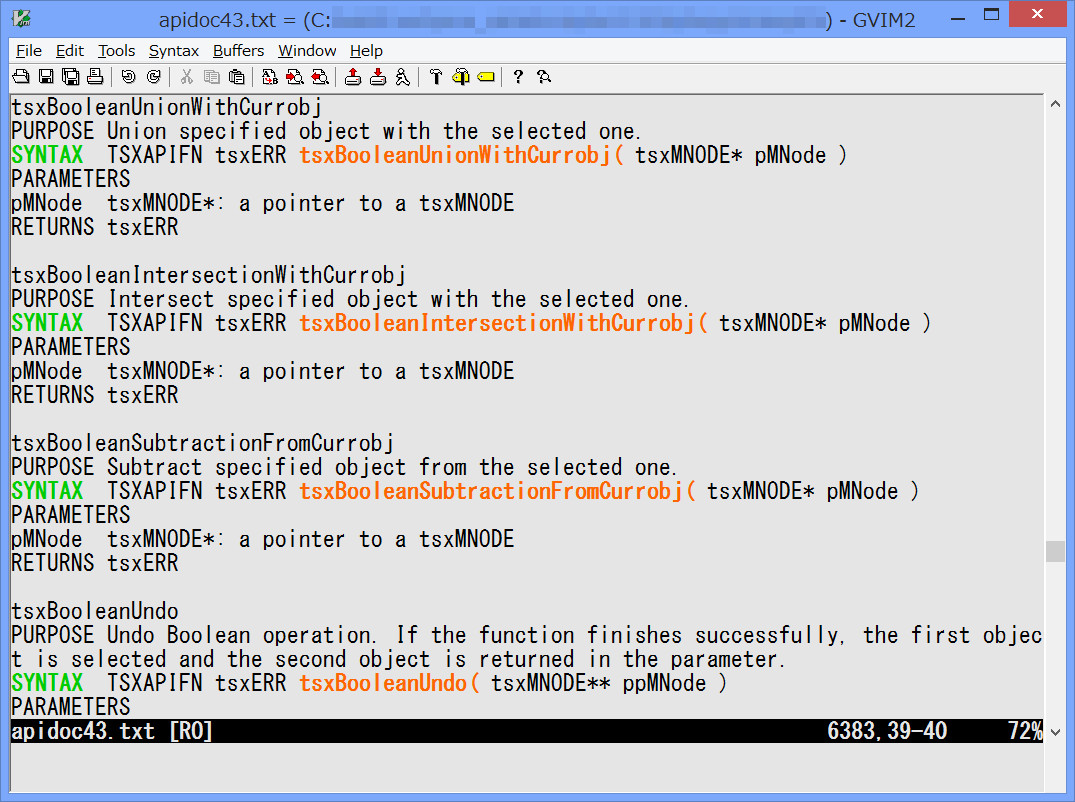Vim highlighting for ptsxpy scripts
The author mainly uses a text editor "Vim" to edit script files. It already has syntax-highlighting for Python, and I added ptsxpy specific highlighting setting to it.

In example above, I am using "morning" color scheme (by specifying a line "colorscheme morning" to gvimrc file) and editing a script file with file extension ".py". According to the file extension and color scheme setting, Vim highlights words; comment is blue, string literal is pink, print is ocean green, reserved keyword is bold and dark red, etc.
However, Vim never knows about ptsxpy syntax and API functiopns. There are about 850 thru 1300 API functions (varies per tS version) defined in tsxAPIxx.doc and header files. I added a file in order to highlighte ptsxpy predefined classes, "p.xxxxxx", "ptsxgp.xxxxxx", etc. The code below is of the file "syn1.vim".
Code: Select all
sy match meth1 "\<p\>\.[a-zA-Z0-9_]*"
sy match meth2 "ptsxgp\.[a-zA-Z0-9_]*"
sy match pointer1 "\.p\>"
sy keyword class1 Vec3f Vec2f Vec3fArray Axes3f Txmx3f BBox3f WidgetReg CollisionReport Quaternion ViewParam WDG_CALLBACKS Color SurfaceProps ProTexGranite ProTexMarble ProTexWood TextureProps BumpProps Txmx2f Rect FaceVx FaceVxArray Face FaceArray Hole UV Edge EdgeArray LatticeVector LatticeFloor MatRectProps DerivCurves SubDivEdge SubDivEdgeArray SubDivFace SubDivFaceArray PhysEnvir FloatColor RenderToFileData RenderData Image TextureFromLightingData String CharArray UcharArray Float FloatArray Double DoubleArray Long LongArray Ulong Short Ushort IntArray
sy keyword class2 Vec3f_p Vec2f_p Vec3fArray_p Axes3f_p Txmx3f_p BBox3f_p WidgetReg_p CollisionReport_p Quaternion_p WDG_CALLBACKS_p Color_p SurfaceProps_p ProTexGranite_p ProTexMarble_p ProTexWood_p TextureProps_p BumpProps_p Txmx2f_p Rect_p FaceVx_p FaceVxArray_p Face_p FaceArray_p Hole_p UV_p Edge_p EdgeArray_p LatticeVector_p LatticeFloor_p MatRectProps_p DerivCurves_p SubDivEdge_p SubDivEdgeArray_p SubDivFace_p SubDivFaceArray_p PhysEnvir_p FloatColor_p RenderToFileData_p RenderData_p Image_p TextureFromLightingData_p String_p CharArray_p UcharArray_p Float_p FloatArray_p Double_p DoubleArray_p Long_p LongArray_p Ulong_p Short_p Ushort_p IntArray_p
sy match comma1 ","
hi meth1 guifg=#d25400
hi meth2 guifg=#666633
hi class1 guifg=#006388 gui=bold
hi class2 guifg=#810083 gui=bold
hi pointer1 guibg=#e6c6ff
hi comma1 guibg=#cccc99 gui=bold
- methods of ptsxpy. It begins at "p." and ends at "(". Orange letters.
- methods of ptsxgp. It begins at "ptsxgp." and ends at "(". Dark Orange letters.
- ptsxpy predefined class. It has specific name. Sky Blue letters
- inherited class for pointer. Its name is base class (i.e. parent's) name + "_p". Purple letters.
- pointer member of ptsxpy predefined class instances. It is ".p". Light Mauve background.
Usage:
- Make a text file in any folder you like, and rename it to "syn1.vim". It's convenient to put it near your ptsxpy script files (e.g. parent folder of scripts). It's not recommended to put it in the Vim installed directory because you might forget that and do Vim update.
- Copy & paste the above code (with sy and hi) to it.
- Locate to the folder where your Vim was installed, and find a file "gvimrc".
- Open gvimrc using your text editor. (Note: It's not vimrc but gvimrc. The g means "graphical" Vim.)
- (option) Find a line of "colorscheme" and change its value to your favorite one if needed. (You can get a list from Vim menu - Edit - Color Scheme.)
- Add a line to the last of vimrc as below. It lets Vim to read the syn1.vim when user open a file with file extension ".py". (Change c:/aaaa/bbbb into your path where your syn1.vim is.)
Code: Select all
autocmd BufReadPost *.py :source c:/aaaa/bbbb/syn1.vim
Please note that this topic might not incorporate the latest information (especially not all class names might be listed in the code above). Change the code for highlighting if needed.
Vim highlighting for tsxAPI document
The author has 4 plain text files; apidoc43.txt, apidoc51.txt, apidoc60.txt, and apidoc66.txt. I copied all text from the tsxAPIxx.doc for each trueSpace version to corresponding file of them, and gave another line in my gvimrc in order to let Vim highlight tsxAPI fuctions;
Code: Select all
autocmd BufReadPost apidoc*.txt :source c:/cccc/dddd/syn2.vim
Code: Select all
sy match tsx "tsx[a-zA-Z0-9_]* *("
sy match syn "SYNTAX"
hi tsx gui=bold guifg=#ff6600
hi syn gui=bold guifg=#00cc00

That is very convenient because I can search words in a moment unlike the original document.
For your information; Most parts of ptsxpy C++ source code (i.e. functions to bridge Python script and C++ API) and SQL for Syntax search page are generated from the four apidocX.txt using Cygwin + bash script + awk scripts + sed scripts.
